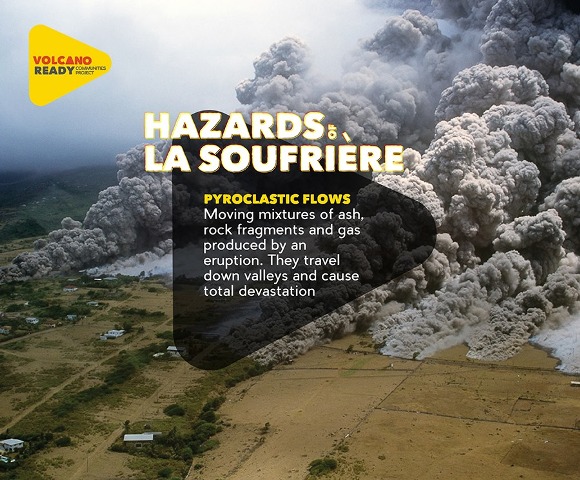 St Vincent's communities project advice. [photo shared by UWI's Seismic Unit]
St Vincent's communities project advice. [photo shared by UWI's Seismic Unit]
The eruption of La Soufrière has left ‘apocalyptic’ scenes, said the United Nations, as it appealed for $29m in emergency aid for St Vincent.
The initial eruption forced the evacuation of about 16,000 people – about a sixth of the population on the Caribbean island – though the UN said ‘the vast majority of the population has been adversely impacted by this disaster’.
Ralph Gonsalves, the prime minister, said officials were still quantifying the damage, but that rebuilding would cost ‘hundreds of millions of dollars’ on top of ‘massive’ humanitarian relief needs. ‘We have been set back decades,’ he said.
After lying dormant since 1979, seismic activity began last November and a lava dome began to form on La Soufrière the following month as gas and steam emissions increased, according to the Smithsonian Institution’s Global Volcanism Programme. By January the dome had swollen to a height of 90 metres, with temperatures of 590C. Fifty earthquakes an hour were being recorded by late March. La Soufrière finally erupted on 9 April, blasting more than 460m tonnes of ash and rock into the sky. Successive explosions and pulses of ash fed the plume for hours and it eventually rose 16km (52,000 ft). The island’s international airport had to close and some houses collapsed under the ashfall, while lava flowed for several kilometres and reached the sea. Ash fell on neighbouring islands, including Barbados, 165km away, and the plume of sulphur dioxide reached as far as Niger in Africa. Further eruptions and emissions continued over the following 10 days.
The eruptions had left the population of St Vincent without clean water or electricity, the UN said. Stéphane Dujarric, spokesman for the UN secretary-general, António Guterres, said ‘the eruption has affected most livelihoods’ of those in the north of the island, including banana farming, with ‘ash and lava flows hampering the movement of people and goods’.
Didier Trebucq, UN coordinator for the eastern Caribbean, described the scene as ‘apocalyptic’, adding: ‘The devastating impact of this event on thousands of people is undeniable.’
The St Vincent and the Grenadines finance minister, Camillo Gonsalves, told Channel 4 News that the country had taken a ‘massive hit’ and recovering from the eruption could cost half the nation’s gross domestic product. A year’s worth of crops had been destroyed, as ash had blanketed the most productive areas. With 20% of houses severely damaged or destroyed, and restoring water supplies likely to take months, Gonsalves put the costs of humanitarian aid, clean-up and infrastructure repairs at $350m and that was with his team not yet having fully toured the worst-affected areas.
With the rainy season and hurricanes due to hit St Vincent, concerns have been growing that volcanic mudflows, called lahars, would further ravage the island. Scientists estimate that 100m cubic metres of ash have fallen and Prof Richard Robertson, at the University of the West Indies’ Seismic Research Centre, warned that rains could unleash fast-flowing rivers of mud and debris capable of great damage.



